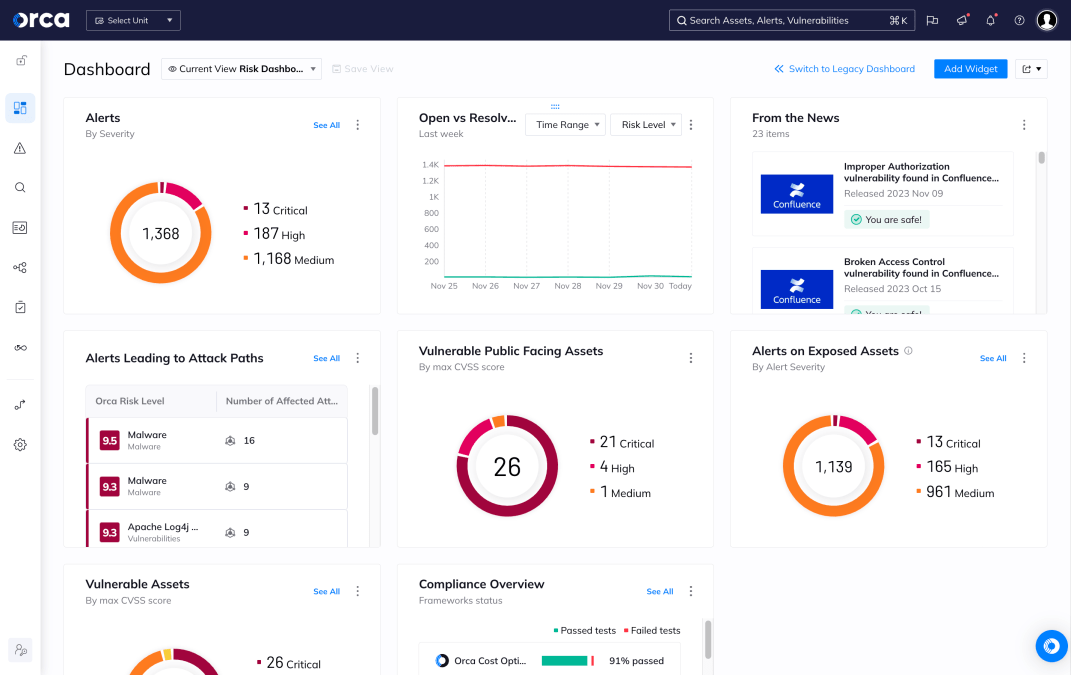Vulnerability refers to a weakness or flaw in a system, application, network, or configuration that could be exploited by a threat actor to compromise confidentiality, integrity, or availability. Vulnerabilities can result from coding errors, misconfigurations, design oversights, or insecure defaults and are among the most common entry points for cyberattacks.
Managing vulnerabilities effectively is critical to reducing risk, preventing breaches, and maintaining the overall security posture of modern IT and cloud environments.
What is a vulnerability?
A vulnerability is a security gap that, if discovered and exploited, allows an attacker to perform unauthorized actions. These could include executing arbitrary code, accessing sensitive data, escalating privileges, or disrupting service availability.
Common types of vulnerabilities include:
- Software bugs: Logic flaws, buffer overflows, and input validation errors
- Misconfigurations: Overexposed resources, overly permissive IAM policies, open ports
- Unpatched software: Known issues for which fixes exist but haven’t been applied
- Weak credentials: Default passwords or lack of multi-factor authentication (MFA)
- Insecure dependencies: Outdated or vulnerable open-source packages
Vulnerabilities are tracked in public databases such as the Common Vulnerabilities and Exposures (CVE) list and are often scored using the Common Vulnerability Scoring System (CVSS) to reflect their severity.
Why vulnerabilities matter
Vulnerabilities are one of the most exploited elements in cyberattacks. Left unaddressed, they:
- Provide initial access to attackers
- Enable lateral movement within compromised environments
- Allow privilege escalation and control over systems
- Contribute to data breaches, ransomware infections, and service disruptions
Effective vulnerability management is foundational to modern cybersecurity programs, particularly in environments with rapid software development cycles, cloud-native architectures, and distributed teams.
Vulnerabilities in cloud environments
In the cloud, vulnerabilities extend beyond traditional operating system or application flaws and can include:
- Misconfigured cloud storage (e.g., public S3 buckets)
- Over-permissioned identities with excessive access to services
- Exposed secrets in code repositories or environment variables
- Vulnerable container base images or unscanned container registries
- Insecure APIs and serverless functions
Because cloud environments are highly dynamic and ephemeral, detecting and prioritizing vulnerabilities requires continuous visibility and context about how assets interact and what data they access.
Vulnerability assessment vs. vulnerability management
- Vulnerability assessment is the process of identifying and evaluating security weaknesses through scans and analysis.
- Vulnerability management is a broader, ongoing program that includes assessment, prioritization, remediation, and verification.
A mature vulnerability management program considers exploitability, asset criticality, reachability, and potential impact—not just severity scores.
How vulnerabilities are prioritized
Organizations typically use a combination of the following to prioritize vulnerabilities:
- CVSS score: Industry-standard rating of severity (ranging from 0.0 to 10.0)
- Exploitability: Whether public exploits exist or if the vulnerability is actively exploited
- Asset exposure: Whether the vulnerable system is accessible from the internet or other attack paths
- Business impact: Whether the asset handles sensitive data or performs critical functions
- Reachability analysis: Whether the vulnerability is actually accessible based on real-world context
Combining these factors helps reduce alert fatigue and focus remediation on the vulnerabilities that matter most.
How Orca Security helps
The Orca Cloud Security Platform continuously scans cloud environments—including AWS, Azure, Google Cloud, Oracle Cloud, Alibaba Cloud, and Kubernetes—for vulnerabilities across runtime and development environments.
With Orca, organizations can:
- Leverage more than 20 vulnerability data sources to detect and prioritize vulnerabilities across your entire cloud estate.
- Perform Reachability Analysis to prioritize vulnerable packages that attackers can actually exploit in runtime
- Take advantage of AI-driven capabilities to remediate vulnerabilities fast and easily—and from Cloud-to-Dev
- Integrate security findings with SCM platforms and ticketing systems to streamline remediation
By providing full-stack visibility with contextual prioritization, Orca enables security teams to enhance their vulnerability management programs and reduce the likelihood of exploitation.



